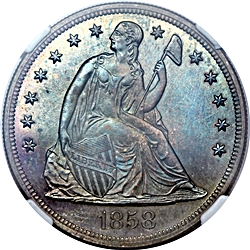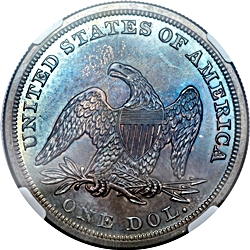 |
1858 
 |
 |
General Comments1858 is one of the most desirable dates in the Liberty Seated dollar series due to its low mintage, rarity, and its status as a proof-only issue. No mint records have been found, but most estimates put the mintage at around 300 pieces. With this mintage ranking 3rd out of 47 the collector would expect that it would be incredibly rare. However, since all the coins issued were minted for collectors the survival rate is considerably higher than that of dates that were struck for use in commerce. Examples are expensive but available. Ten or more are offered each year, usually at auctions. Examples are occasionally found in dealer inventories. Several of the earlier dates in the 1850’s are tougher to find than the 1858. And since the 1858’s were minted as proofs it’s easy to find a premium quality example. |
|
Strike isn’t an issue for this date since all were proofs. The obverse strikes are almost always needle sharp. The reverses sometimes show some weakness on the upper edge of the left wing. It’s possible that these coins were struck in two different groups, one of which shows the reverse weakness. The well-struck coins seem to be slightly more prevalent.
1858 Die Marriages
Two die marriages have been identified for 1858. A single obverse die was paired with two different reverse dies. The following table summarizes the known die marriages:
Die Marriage |
Rarity |
Obverse Die |
Reverse Die |
Estimated Survivors |
| OC-P1 | R4- | P1 | 1856 PA | 175 |
| OC-P2 | R7+ | P1 | 1859 PA | 5 |
The more common die marriage, our OC-P1, pairs the 1858 obverse with Reverse 1856 PA, previously used to strike proofs in 1856, and 1857. The finest known example is a PR67+ graded by NGC.
The second die marriage, our OC-P2, is somewhat controversial. This marriage pairs the same obverse die used for OC-P1 with a reverse die that is seen on 1859 regular issue proofs and 1851, 1852, and 1854 restrikes. Several references indicate that this die marriage is as common (or nearly so) as the OC-P1 marriage. Our research shows that it’s at least R7+, with 5 or less coins existing. After reviewing over 60 auction records, representing nearly 50 different coins, we found only two examples. An NGC PR65 with a CAC sticker was sold in the Winter FUN auction in January, 2012. A PCGS PR64 with a CAC sticker was sold by Stacks-Bowers when they auctioned the Blue Moon collection in March, 2017.
Based on our analysis of the obverse die states we believe that OC-P1 is the earlier issue. This makes it very possible that OC-P2 is a restrike, since the same reverse was used to strike at least three other restrikes. However, we haven’t been able to personally examine an example of the OC-P2 die marriage, so our conclusion is based only on high resolution photos. If we have an opportunity to examine an example of OC-P2 it may be possible to compare the state of the 1859 PA die to confirm that the 1858 coins were minted after 1859. We should also note that we’ve seen several examples of OC-P1 that exhibit an unfinished area under the chin that’s much less than many examples of that die marriage, and also much less than the two examples we’ve seen of OC-P2. That would mean that part of the OC-P1 mintage was produced at a different time, after the obverse die had been polished, and after the OC-P2 mintage. Thus, it’s possible that both OC-P2 and part of the OC-P1 mintage are restrikes.
1858 Emission Sequence
Emission sequence is important for this year because we believe that both OC-P2 and part of the OC-P1 mintage are restrikes.
Emission Order |
Die Marriage |
Comments |
| 1 | OC-P1 | |
| 2 | OC-P2 | Unfinished area under the chin reduced, indicating that the die was polished either during the OC-P1 run or between OC-P1 and OC-P2. We believe that these are probably restrikes. |
| 1 | OC-P1 | Several examples have been seen with the unfinished area under the chin significantly reduced relative to both the early strikes of OC-P1 and OC-P2. This means that some OC-P1 examples represent remarriages. These would also be restrikes. |
It should be noted that the obverse die states of OC-P1 and OC-P2 are virtually identical, so our emission sequence conclusion has some degree of uncertainty. We’re hoping that at some time in the future we’ll have an opportunity to examine several coins together, including an example of the OC-P2 die marriage, to increase our confidence in the emission sequence described above.
1858 Quick Finder Chart
With only 1 obverse die and 2 die marriages 1858 die marriages are relatively easy to identify. The following chart gives the key attribution points for each die marriage.
Die Marriage |
Obv. Die |
Rev. Die |
Right Base |
Keys to Identification |
| OC-P1 | P1 | 1856 PA | L QTR | Obverse – Centered date. Reverse – Small lumps on the top of the lower left side of the L in DOL. |
| OC-P2 | P1 | 1859 PA | L QTR | Obverse – Centered date. Reverse – Notable lumps in the eagle's lower left wing. |
| Photo credits:
Obverse and reverse full photos: 1858 NGC PR66, ex. Kaufman/ Gardner, from the Heritage archives. |
